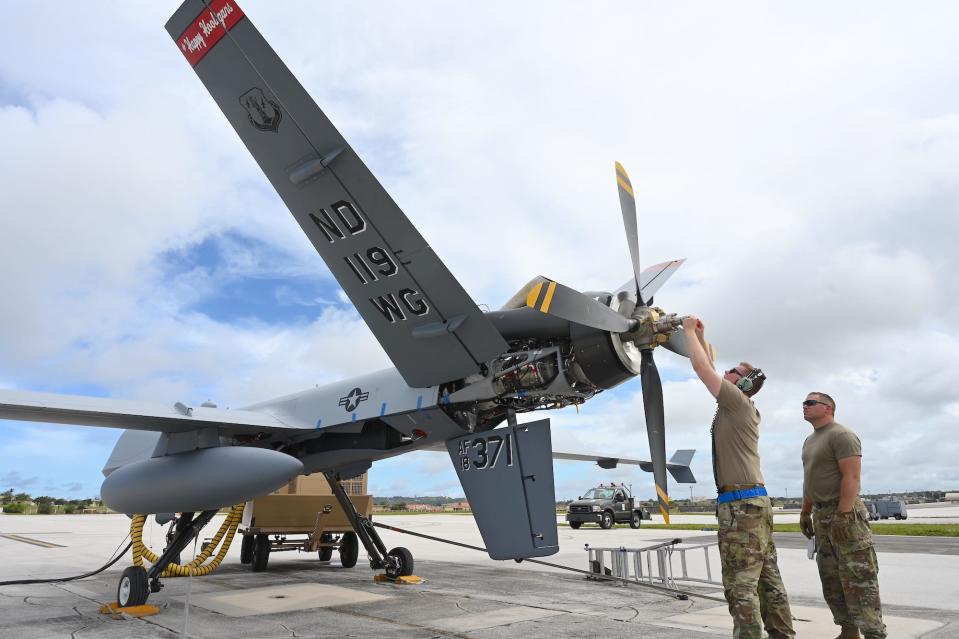The US Air Force is using satellites and dirt runways to prepare its drones for a different kind of war
The war in Ukraine has highlighted how hard air operations are in a large conventional conflict.
The war has also shown the value of drones—big and small, cheap and expensive—to modern militaries.
The US Air Force is already training to keep its drones flying by spreading out and using new tech.
As the war in Ukraine unfolds, the US military is watching and learning valuable lessons.
The war has underscored for the Pentagon how valuable drones will be as well as how difficult it will be to keep those and other aircraft operating in a large-scale conventional conflict.
The US military is already preparing to give unmanned aerial systems more missions in a potential war with China or Russia. In exercises this summer, US airmen trained to use drones for a wider set of operations in a variety of different settings.
A new way of fighting

In a large-scale conflict with a near-peer adversary, like Russia or China, the US's biggest airbases and ones close to frontline would likely come under sustained attack. In response to that challenge, the Air Force is training to disperse its forces and make targeting harder for enemies.
In June, US airmen landed an MQ-9 Reaper drone on a dirt runway for the first time, showcasing the aircraft's ability to operate in austere environments.
During that exercise, the MQ-9 successfully carried an experimental travel pod with supplies for ground troops. The pod may not carry much, but it could deliver "critical items to austere locations," an officer involved in the test said, calling it the "Reaper Express."

During another exercise in July, US airmen for the first time relied on satellite communications to conduct an MQ-9 Reaper mission using just a mission-control element.
Normally, drone operations have a launch-and-recovery element, which oversees takeoff and landing, and a mission-control element, which operates the drone, usually from hundreds of miles away.
For the July exercise, called Grand Warrior, airmen assigned to the mission-control element received training on launch and recovery procedures and then used satellite communications to conduct their missions with the help of a system called Automatic Takeoff & Land.
Using only the mission-control element allowed the unit to reduce the number of personnel and amount of equipment it needed, shrinking their overall footprint. A smaller footprint means drone units can move away from main hubs and use more remote, less developed airfields.

These exercises reflect the Air Force's intention to use drones in a wider role, over longer distances, and from a greater range of bases — all in keeping with its focus on Agile Combat Employment, an approach to dispersed operations that is meant to make Air Force units more flexible and harder for rivals, especially China, to track and shut down.
During ACE exercises like Grand Warrior, airmen have been training on different capabilities, such as Forward Arming and Refueling Points, that allow them to quickly reposition aircraft at forward positions and simulate real-world missions, like having to relocate and set up improvised airfields if Chinese or Russian forces target their large main airbases.
Landing fighter and attack jets on roads and highways is also a part of ACE that the US and its allies are focusing on, doing it with a variety of aircraft, including drones, in the US and in Europe.
A cultural milestone

The US military used Reapers and drones like it extensively in its counterterrorism and counterinsurgency campaigns in the Middle East and Africa, but the war in Ukraine has shown that drones of all sizes and types are needed in modern warfare.
Russia and Ukraine have used unmanned aerial systems — both military-grade and modified commercial drones — extensively for a variety of missions, including reconnaissance, strike, and electronic warfare. While US troops have used drones, big and small, for years, the Pentagon is still integrating them into its formations.
For the US Air Force, the growing focus on incorporating drones into its operations is a significant milestone for a service that since its founding has been oriented around human pilots.
The policies and thinking of US military service branches are often guided by members of a few communities within them. For the US Air Force, fighter pilots have long been that dominant influence. Of 22 Air Force chiefs of staff, the service's highest-ranking uniformed officer, 17 have come from the fighter/attack communities.
Considering that legacy, the Air Force's embrace of drone aircraft is a sign of how service leaders' mentality and expectations about the future battlefield are changing.
Stavros Atlamazoglou is a defense journalist specializing in special operations and Hellenic Army veteran (national service with the 575th Marine Battalion and Army HQ). He has a B.A. from the Johns Hopkins University, an M.A. in strategy, cybersecurity, and intelligence from the Johns Hopkins School of Advanced International Studies, and is currently pursuing a Juris Doctor degree from Boston College Law School.
Read the original article on Business Insider


